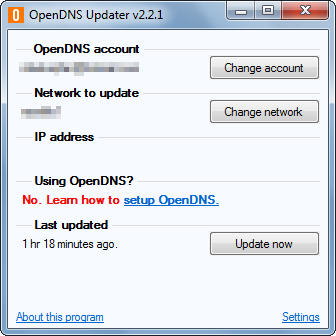
OpenDNS gives you a relatively barebones approach to parental controls – filtering and logging – but that may be enough for many families. You can even download a copy of the log or output to a printer. Stats can be shown for a range of dates, whether it’s the most recent week, or a whole month, you can look at requests and see what websites your clients are visiting. But if you want to know what kind of traffic is going in and out of your network, you’ll want to take a glance at network stats. You might be happy with the way OpenDNS filters web content and if so, that’s great. In addition to the OpenDNS’s filters, there’s a great many other options you can investigate, but before we conclude today, we want to touch upon the “Stats” features found in OpenDNS. Right-click on that network icon, in this screenshot, it’s a wired connection but on your computer it may be a Wi-Fi bars. We’ll show you the screenshots from Windows 8.1.īoth Windows systems should have an icon of the network to which you are connected in the lower-right corner of the taskbar. On Windows 7 and Windows 8.1, the routes and ends are the same. That said, we’re going to show you how to configure Windows clients with OpenDNS’s settings. Changing DNS Servers on Windows Computers The other option for an OpenDNS configuration is to change each client in your network, or you can change the DNS on your router, and Mom and Dad can configure their own computer with their ISP’s DNS server settings, or they can use Google’s public DNS servers (8.8.8.8 and 8.8.4.4), to access the Internet unfettered. Alternative Method: Configuring Individual Clients Simply open the Safari’s preferences (the fastest way to do this is to use “Command + ,”) and then click on the “Privacy” tab.Ĭlick “Remove All Website Data…” and then “Remove Now” on the subsequent screen. Once you’re ready to commit, click “Clear browsing data” and everything in the cache will be wiped clean. We want to “obliterate” browsing data from “the beginning of time.” Make sure you’ve have selected “Cache images and files” from the list. On the resulting History screen, click “Clear browsing data…” to delete the cache. You will know you have administrator privileges because it will say so in the title bar. Instead of simply hitting “Enter” though, use “Ctrl + Shift + Enter” to open an administrator command prompt.

Open a command prompt on Windows 7 or Windows 8.1 by opening the Start menu or Start screen, respectively, and entering “cmd” in the search box. Clearing Your DNS Resolver Cache on Windows Clients That is all you need to do to your router, all DNS requests will now be routed through OpenDNS, however, you still need to flush your DNS resolver cache and web browser cache. Depending on your router, it may be an actual “Save” button or it may say “Apply.” Regardless, if you don’t commit your changes, they won’t take effect. Once inputted, you will need to save your changes. In the screenshot below, we see where we enter that on our router. Once you’ve got your router open, you want to locate where you can input different DNS servers.


 0 kommentar(er)
0 kommentar(er)
